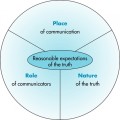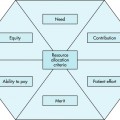3 After completing this chapter, the reader will be able to perform the following: • Identify the nature of care and its ethical and legal implications. • Provide examples of the impact of communication on imaging. • Define human care, professional care, and communication. • Explain care and communication as a context for imaging practice. • Develop a more caring and communicative demeanor. • Identify what health literacy is and how it affects imaging. Caring and communication are essential for life and growth; they are crucial ingredients in the imaging professional’s ability to serve the needs of self and others. Caring and communication require the developmental strengths of trust, autonomy, initiative, identity, justice, industry, and intimacy, all of which play a role in discussions of ethics and ethical problem solving for the imaging professional.1 Caring is defined as a function in which a person expresses concern for the growth and well-being of another in an integrated application of the mind, body, and spirit designed to maximize positive outcomes. Expressions of caring include feelings of compassion and concern, a philosophy of commitment, an ethical approach to problems, altruistic acts, conscious attention to the needs and wishes of others, protection of the well-being of others, nurturing of growth, and empathy and advocacy. Because caring plays such a vital role in human interaction, an appreciation of caring is fundamental to an understanding of human nature.2 Such activities as listening, providing information, helping, communicating, and showing respect are expressions of caring.3 Other caring activities include touching, nurturing, supporting, and protecting (Box 3-1).4 Caring is a universal phenomenon, although expressions, processes, and patterns may vary among cultures.5 Caring is essential in the development of the imaging professional.6 Radiographers must be caring individuals, part scientist and part humanist. Humanism entails the provision of existential care, a more abstract form of care arising from an awareness of common bonds of humanity and common expressions, fates, and feelings.7 Care may occur as a product of the rapport between imaging professionals and patients. Unfortunately, this is not always the case8: Philosophically, care is an ideal analogous to beauty, truth, and justice; although it is sought after, it can never be fully attained or perfect in human expression. Imaging professionals are not capable of providing perfect care. In striving for the ideal, however, the imaging professional may occasionally come close to achieving it and in so doing provide great benefits for the patient. One danger in discussing ideals is viewing them as achievable and measurable commodities; this leads to the idea that those who fall short of achieving ideal care should be ashamed.7 This misperception may lead imaging professionals who consider caring to be a vital part of their professional practice to feel guilty, selfish, or discouraged when they are unable to give more time to their patients.9 Professional care is characterized by the application of the knowledge of a professional discipline, including its science, theory, practice, and art. It is complementary to human caring. Imaging professionals must possess human caring before they are able to provide professional caring. Human and professional caring are both activities of the whole person (although activities are only a portion of caring). The interaction of compassion, knowledge, and the experiences and emotions of the whole person gives rise to human and professional caring.7 Clearly, professional expertise unaccompanied by human compassion is not enough to serve all the needs of the patient: “If we fail to motivate that feeling (empathy and compassion) and the earnest desire within our student to help our fellow man, we will have created the equivalent of human robots.”10 Such an emphasis on skill at the expense of caring and empathy produces a “patient care gap” in which the patient is ignored as the “scale tips toward science and technique.”11 The professional and human caring practiced by imaging professionals is based on individual and institutional values. Adherence to a set of values and the use of ethical problem solving help the imaging professional to develop a more caring demeanor. The three strengthen one another. Without values, caring and ethics in the imaging health care environment are without foundation and force. In turn, a strong commitment to caring requires a fusion of feeling, thought, and action, all of which aid the technologist in coping with stress and solving problems ethically. Taken together, caring, values, and ethical problem solving give meaning to professional practice, create the possibility of ever-improving care, and enhance patient comfort and feelings of safety.2 For example, cardiac ultrasonographers who have the ability to make their patients comfortable find them more willing to comply with directions, leading to an examination with greater diagnostic success. Caring in the imaging sciences also involves an appreciation of the universal patterns of human experience. As imaging students enter educational programs, they are exposed through their patients to the universality of pain, loneliness, suffering, fear, and looming death. Human caring and professional caring require compassion for the suffering endured by patients and an understanding of the ways in which people construct and draw meaning from their lives. This unending activity of inventing, restructuring, and reinterpreting is universal, even though the outcomes are personal. Compassionate imaging professionals respond to the universal appeal made by suffering human beings by caring. The potential for this response is also universal.7
Caring and Communication
ETHICAL ISSUES
DEFINITION OF CARING
Care as an Ideal
PROFESSIONAL CARE
Caring in the Imaging Sciences
Caring and Communication








